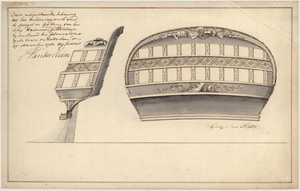 Stern of the ship Wassenaar Stern of the ship Wassenaar
| |
| History | |
|---|---|
| Name | Wassenaar |
| Builder | Zwindrecht, Rotterdam |
| Launched | 1781 |
| Commissioned | 1781 |
| Name | Wassenaar |
| Out of service | 1797 |
| Fate | Captured |
| Name | HMS Wassenaar |
| Acquired | 1797 |
| Commissioned | 1797 |
| Decommissioned | 1815 |
| Reclassified | Powder hulk in 1802 |
| Fate | Sold for breaking up, 1818 |
| General characteristics | |
| Class and type | 64-gun third rate ship of the line |
| Tons burthen | 1,269 48⁄94 (bm) |
| Length | |
| Beam | 42 ft 8 in (13.0 m) |
| Depth of hold | 20 ft 2.5 in (6.2 m) |
| Sail plan | Full-rigged ship |
| Complement | 491 (250 as troopship) |
| Armament |
|
Wassenaar was a Dutch 64-gun third rate ship of the line of the navy of the Dutch Republic and the Batavian Republic, and the Royal Navy. The order to construct the ship was given by the Admiralty of the Meuse. The ship was commissioned in 1781. In 1783/1784, the Wassenaar sailed to Batavia under Captain Gerardus Oorthuis.
In 1795, the ship was commissioned in the Batavian Navy.
On 11 October 1797 the Wassenaar took part in the Battle of Camperdown under Captain Adolph Holland. Holland was killed during the battle, and his ship surrendered to HMS Triumph. HMS Triumph then sailed on to the centre of the battle, and when the Wassenaar was fired on by a Dutch brig, the crew raised the Dutch colours again. But in the end they were captured again by the British.
As HMS Wassenaar, the ship first served as a troop ship. In February 1798 she was the flagship of Admiral Joseph Peyton in the Downs.

In the years 1800-1802 she served in the Mediterranean. In her final years (1802-1815) she lay at Chatham as a powder hulk, until she was finally sold for breaking up in 1818.
References
- J.F. Fischer Fzn. De Delft: De dagjournalen met de complete en authentieke geschiedenis van 's Lands schip van oorlog Delft en de waarheid over de zeeslag bij Camperduin (Franeker: Van Wijnen, 1997), 135.
- Nieuwe Nederlandsche Jaarboeken, achttiende deel, derde stuk (Amsterdam : Erven F. Houttuyn, Leiden, P. van der Eyk en D. Vyg, 1783), 2221.
- William Laird Clowes, The Royal Navy: A History from the Earliest Times to 1900, Volume IV (London: Chatham Publishing, 1997), 54.
- Willis, Sam (2013). "Wassenaar (64)". In the Hour of Victory: SHORTLISTED FOR THE MARITIME MEDIA AWARDS. Atlantic Books Ltd. pp. 130–153. ISBN 9780857895721. Retrieved 11 April 2021.
| Shipwrecks and maritime incidents in 1797 | |
|---|---|
| Shipwrecks |
|
| Other incidents |
|
| 1796 | |